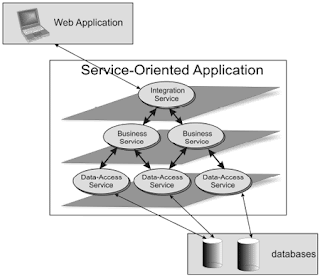Service Oriented Architecture
Introduction
The service-oriented architecture SOA is one of the buzzwords. Not a solution for all applications, the truth is that it has significant advantages in response to business problems.
The concept of SOA (Service Oriented Architecture) provides a framework to align business processes with IT systems. It is a platform of services that represent business processes that combine to provide suitable solutions for different business needs.
Among the most obvious and immediate benefits, is to offer greater flexibility and reusing processes to accommodate the new information system of the company, thus adapting to change with the least possible cost and time.
What is SOA?

SOA is a conceptual framework, not about hardware, software or programming language. Is the union of business objectives with IT infrastructure, integrating business logic and data from all systems, leveraging the network and Web Services. This architecture describes the standard ways to deliver services business processes through developing interfaces between services to cooperate easily.
These are other definitions of large corporations that work with SOA:
SOA is a component model that interrelates the various functional units of the application, called services, through well defined interfaces and contracts between these services. The interface is defined in a neutral manner and should be independent of hardware platform, operating system and programming language used. This allows services, built on heterogeneous systems interact with each other in a uniform and universal.
The SOA architecture design provides a framework for integrating separate applications so that from the network to access its features, which are offered as services.
SOA Fundamentals
Generically SOA is based on the following fronts:
- Run quickly adapt to market, win the competition.
- Reuse components of business processes.
- Measure the results and take action on them.
- Ensure that results are repeatable and predictable.
- Start where necessary (business area - area of technology).
The SOA architecture defines the following aspects:
Before SOA
In traditional IT architectures, data, applications and business process activities are often locked in "silos" that are separate and incompatible costly to maintain and make users have to navigate on different networks, applications and databases for specific business tasks.
After SOA
With a service-oriented architecture (SOA), users no longer have to login to multiple systems, search for relevant data and integrate the results manually. The data for business process activities is delivered as an integrated service, in a single application with a single login.
In traditional IT architectures, data, applications and business process activities are often locked in "silos" that are separate and incompatible costly to maintain and make users have to navigate on different networks, applications and databases for specific business tasks.
After SOA
With a service-oriented architecture (SOA), users no longer have to login to multiple systems, search for relevant data and integrate the results manually. The data for business process activities is delivered as an integrated service, in a single application with a single login.
Benefits of SOA
- Reduce costs and development time, SOA services can be easily reused and can develop into new composite applications
- Reduce maintenance costs-reusable services reduce the degree of internal complexity of IT services
- Improve the quality of services-Increased service reuse creates higher-quality services in multiple testing cycles from different service consumers
- Reduce the costs of integration, standardized services can work together, allowing disparate applications to connect quickly and easily
- Reduce the risk-less reusable services provide greater control over government policies and corporate IT.



No hay comentarios:
Publicar un comentario